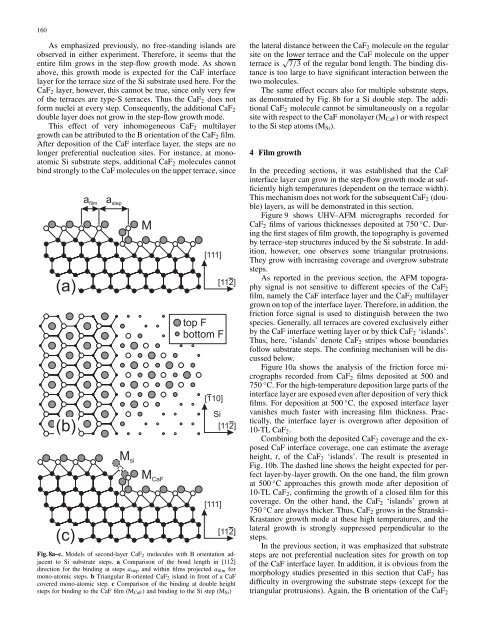Substrate-step-induced effects on the growth of CaF2 on Si (111)
Substrate-step-induced effects on the growth of CaF2 on Si (111)
Substrate-step-induced effects on the growth of CaF2 on Si (111)
- No tags were found...
Create successful ePaper yourself
Turn your PDF publications into a flip-book with our unique Google optimized e-Paper software.
160As emphasized previously, no free-standing islands areobserved in ei<strong>the</strong>r experiment. Therefore, it seems that <strong>the</strong>entire film grows in <strong>the</strong> <str<strong>on</strong>g>step</str<strong>on</strong>g>-flow <strong>growth</strong> mode. As shownabove, this <strong>growth</strong> mode is expected for <strong>the</strong> CaF interfacelayer for <strong>the</strong> terrace size <strong>of</strong> <strong>the</strong> <strong>Si</strong> substrate used here. For <strong>the</strong>CaF 2 layer, however, this cannot be true, since <strong>on</strong>ly very few<strong>of</strong> <strong>the</strong> terraces are type-S terraces. Thus <strong>the</strong> CaF 2 does notform nuclei at every <str<strong>on</strong>g>step</str<strong>on</strong>g>. C<strong>on</strong>sequently, <strong>the</strong> additi<strong>on</strong>al CaF 2double layer does not grow in <strong>the</strong> <str<strong>on</strong>g>step</str<strong>on</strong>g>-flow <strong>growth</strong> mode.This effect <strong>of</strong> very inhomogeneous CaF 2 multilayer<strong>growth</strong> can be attributed to <strong>the</strong> B orientati<strong>on</strong> <strong>of</strong> <strong>the</strong> CaF 2 film.After depositi<strong>on</strong> <strong>of</strong> <strong>the</strong> CaF interface layer, <strong>the</strong> <str<strong>on</strong>g>step</str<strong>on</strong>g>s are nol<strong>on</strong>ger preferential nucleati<strong>on</strong> sites. For instance, at m<strong>on</strong>oatomic<strong>Si</strong> substrate <str<strong>on</strong>g>step</str<strong>on</strong>g>s, additi<strong>on</strong>al CaF 2 molecules cannotbind str<strong>on</strong>gly to <strong>the</strong> CaF molecules <strong>on</strong> <strong>the</strong> upper terrace, since(a)(b)(c)a filma <str<strong>on</strong>g>step</str<strong>on</strong>g>MM CaF[<strong>111</strong>]top Fbottom F[<strong>111</strong>][112][ 110]<strong>Si</strong>[112]M si[112]Fig. 8a–c. Models <strong>of</strong> sec<strong>on</strong>d-layer CaF 2 molecules with B orientati<strong>on</strong> adjacentto <strong>Si</strong> substrate <str<strong>on</strong>g>step</str<strong>on</strong>g>s. a Comparis<strong>on</strong> <strong>of</strong> <strong>the</strong> b<strong>on</strong>d length in [11¯2]directi<strong>on</strong> for <strong>the</strong> binding at <str<strong>on</strong>g>step</str<strong>on</strong>g>s a <str<strong>on</strong>g>step</str<strong>on</strong>g> and within films projected a film form<strong>on</strong>o-atomic <str<strong>on</strong>g>step</str<strong>on</strong>g>s. b Triangular B-oriented CaF 2 island in fr<strong>on</strong>t <strong>of</strong> a CaFcovered m<strong>on</strong>o-atomic <str<strong>on</strong>g>step</str<strong>on</strong>g>. c Comparis<strong>on</strong> <strong>of</strong> <strong>the</strong> binding at double height<str<strong>on</strong>g>step</str<strong>on</strong>g>s for binding to <strong>the</strong> CaF film (M CaF ) and binding to <strong>the</strong> <strong>Si</strong> <str<strong>on</strong>g>step</str<strong>on</strong>g> (M <strong>Si</strong> )<strong>the</strong> lateral distance between <strong>the</strong> CaF 2 molecule <strong>on</strong> <strong>the</strong> regularsite <strong>on</strong> <strong>the</strong> lower terrace and <strong>the</strong> CaF molecule <strong>on</strong> <strong>the</strong> upperterrace is √ 7/3 <strong>of</strong> <strong>the</strong> regular b<strong>on</strong>d length. The binding distanceis too large to have significant interacti<strong>on</strong> between <strong>the</strong>two molecules.The same effect occurs also for multiple substrate <str<strong>on</strong>g>step</str<strong>on</strong>g>s,as dem<strong>on</strong>strated by Fig. 8b for a <strong>Si</strong> double <str<strong>on</strong>g>step</str<strong>on</strong>g>. The additi<strong>on</strong>alCaF 2 molecule cannot be simultaneously <strong>on</strong> a regularsite with respect to <strong>the</strong> CaF m<strong>on</strong>olayer (M CaF ) or with respectto <strong>the</strong> <strong>Si</strong> <str<strong>on</strong>g>step</str<strong>on</strong>g> atoms (M <strong>Si</strong> ).4 Film <strong>growth</strong>In <strong>the</strong> preceding secti<strong>on</strong>s, it was established that <strong>the</strong> CaFinterface layer can grow in <strong>the</strong> <str<strong>on</strong>g>step</str<strong>on</strong>g>-flow <strong>growth</strong> mode at sufficientlyhigh temperatures (dependent <strong>on</strong> <strong>the</strong> terrace width).This mechanism does not work for <strong>the</strong> subsequent CaF 2 (double)layers, as will be dem<strong>on</strong>strated in this secti<strong>on</strong>.Figure 9 shows UHV–AFM micrographs recorded forCaF 2 films <strong>of</strong> various thicknesses deposited at 750 ◦ C. During<strong>the</strong> first stages <strong>of</strong> film <strong>growth</strong>, <strong>the</strong> topography is governedby terrace-<str<strong>on</strong>g>step</str<strong>on</strong>g> structures <str<strong>on</strong>g>induced</str<strong>on</strong>g> by <strong>the</strong> <strong>Si</strong> substrate. In additi<strong>on</strong>,however, <strong>on</strong>e observes some triangular protrusi<strong>on</strong>s.They grow with increasing coverage and overgrow substrate<str<strong>on</strong>g>step</str<strong>on</strong>g>s.As reported in <strong>the</strong> previous secti<strong>on</strong>, <strong>the</strong> AFM topographysignal is not sensitive to different species <strong>of</strong> <strong>the</strong> CaF 2film, namely <strong>the</strong> CaF interface layer and <strong>the</strong> CaF 2 multilayergrown <strong>on</strong> top <strong>of</strong> <strong>the</strong> interface layer. Therefore, in additi<strong>on</strong>, <strong>the</strong>fricti<strong>on</strong> force signal is used to distinguish between <strong>the</strong> twospecies. Generally, all terraces are covered exclusively ei<strong>the</strong>rby <strong>the</strong> CaF interface wetting layer or by thick CaF 2 ‘islands’.Thus, here, ‘islands’ denote CaF 2 stripes whose boundariesfollow substrate <str<strong>on</strong>g>step</str<strong>on</strong>g>s. The c<strong>on</strong>fining mechanism will be discussedbelow.Figure 10a shows <strong>the</strong> analysis <strong>of</strong> <strong>the</strong> fricti<strong>on</strong> force micrographsrecorded from CaF 2 films deposited at 500 and750 ◦ C. For <strong>the</strong> high-temperature depositi<strong>on</strong> large parts <strong>of</strong> <strong>the</strong>interface layer are exposed even after depositi<strong>on</strong> <strong>of</strong> very thickfilms. For depositi<strong>on</strong> at 500 ◦ C, <strong>the</strong> exposed interface layervanishes much faster with increasing film thickness. Practically,<strong>the</strong> interface layer is overgrown after depositi<strong>on</strong> <strong>of</strong>10-TL CaF 2 .Combining both <strong>the</strong> deposited CaF 2 coverage and <strong>the</strong> exposedCaF interface coverage, <strong>on</strong>e can estimate <strong>the</strong> averageheight, t, <strong>of</strong><strong>the</strong>CaF 2 ‘islands’. The result is presented inFig. 10b. The dashed line shows <strong>the</strong> height expected for perfectlayer-by-layer <strong>growth</strong>. On <strong>the</strong> <strong>on</strong>e hand, <strong>the</strong> film grownat 500 ◦ C approaches this <strong>growth</strong> mode after depositi<strong>on</strong> <strong>of</strong>10-TL CaF 2 , c<strong>on</strong>firming <strong>the</strong> <strong>growth</strong> <strong>of</strong> a closed film for thiscoverage. On <strong>the</strong> o<strong>the</strong>r hand, <strong>the</strong> CaF 2 ‘islands’ grown at750 ◦ C are always thicker. Thus, CaF 2 grows in <strong>the</strong> Stranski–Krastanov <strong>growth</strong> mode at <strong>the</strong>se high temperatures, and <strong>the</strong>lateral <strong>growth</strong> is str<strong>on</strong>gly suppressed perpendicular to <strong>the</strong><str<strong>on</strong>g>step</str<strong>on</strong>g>s.In <strong>the</strong> previous secti<strong>on</strong>, it was emphasized that substrate<str<strong>on</strong>g>step</str<strong>on</strong>g>s are not preferential nucleati<strong>on</strong> sites for <strong>growth</strong> <strong>on</strong> top<strong>of</strong> <strong>the</strong> CaF interface layer. In additi<strong>on</strong>, it is obvious from <strong>the</strong>morphology studies presented in this secti<strong>on</strong> that CaF 2 hasdifficulty in overgrowing <strong>the</strong> substrate <str<strong>on</strong>g>step</str<strong>on</strong>g>s (except for <strong>the</strong>triangular protrusi<strong>on</strong>s). Again, <strong>the</strong> B orientati<strong>on</strong> <strong>of</strong> <strong>the</strong> CaF 2



